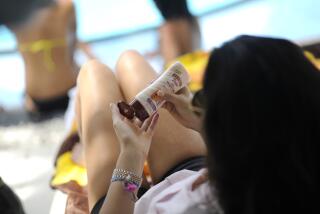Protection turned inside out
Constant worrying about the sun and its power to burn, wrinkle and mottle the skin -- or worse, cause cancer -- comes with the summer territory. But what if there were an extra level of protection, say a pill or a lotion, that helped prevent the most common effects of too much ultraviolet light?
Researchers are working on it.
“Sunscreens are difficult to use properly,” says Daniel Yarosh, president of AGI Dermatics, a Freeport, N.Y., biotech company that is developing a lotion to help the skin mend itself. “Science is trying to find something better.”
The beyond-sunscreens research falls into two categories. One approach helps repair cellular skin damage after too much sun exposure. The other approach makes the skin less sensitive to the sun.
“The research in this field is still relatively early,” says Dr. Henry W. Lim, chairman of the department of dermatology at Henry Ford Hospital in Detroit. “But I think this is something that will continue to develop.”
Repair from within
The most rigorously tested damage-control product thus far is called Dimericine, developed by AGI Dermatics.
Currently in stage-three clinical trials, the product is based on an understanding of how cells try to repair themselves when damaged.
“The idea that people can have a natural repair mechanism is known,” Yarosh says.
“What is new is that there are things we can do to optimize it. We’re moving into a stage of understanding how the cell responds to damage -- what genes get turned on in young skin and what genes get turned on in old skin and how can we make old skin act young.
“That’s what makes this so exciting.”
Dimericine, he says, contains a customized enzyme that can recognize DNA damage caused by ultraviolet light and speed up repair.
“It’s like patching a tire,” he says. “You can get rid of the damage and the DNA goes back to being normal.
“We call it a morning-after lotion. It can be used after sun exposure but before damage has arrived.”
The company is testing the product, which would be available only by prescription, in people with a condition called xeroderma pigmentosum, a rare genetic disease that predisposes individuals to skin cancer. A study of 30 people published in 2001 in the Lancet showed the lotion reduced the incidence of precancerous growths, called actinic keratoses, by 68% and basal cell carcinoma by 30%.
FDA approval, which is unlikely before 2010, would mean that the estimated 58 million Americans with precancerous skin lesions and others at high risk for skin cancer could benefit, Yarosh says.
“If indeed this is shown to be beneficial in otherwise healthy individuals, it would obviously be a very exciting development in this field,” says Lim, who is not involved in the product’s development.
AGI Dermatics also makes an over-the-counter product that purports to help repair DNA-damaged skin cells. Called Remergent, it uses botanical extracts to help stimulate the normal repair mechanism to prevent wrinkles and other cosmetic effects of sun damage.
Protection in a pill?
Meanwhile, several supplement manufacturers are touting sunburn-prevention pills they say can protect the skin by limiting reaction to the sun. The best known is Heliocare, which contains the antioxidant polypodium leucomotos, an extract from a fern that grows in South and Central America.
The substance is thought to decrease the body’s sunburn reaction.
Normally, when ultraviolet light reaches the cells, it creates free radical molecules -- high-energy molecules that damage the proteins and lipids in the cell and eventually lead to photo-aged skin. Polypodium leucomotos appears to help inactivate free radicals before they can damage cells.
“There are quite a number of studies published in the peer-reviewed literature -- although in small numbers of subjects -- to show this product would decrease the ability of the skin to be sunburned, decrease the ability of the skin to tan and the DNA damage that would occur following exposure to the sun,” Lim says.
Other oral antioxidants may also work in a similar manner. Several companies market a supplement containing astaxanthin, a chemical that produces the red coloration in several species of marine life, such as salmon and shrimp. Although trials have been limited, a 2002 study in the Journal of Dermatological Science found that astaxanthin reduced the effects of UVA radiation in cells in a lab culture.
One maker of astaxanthin supplements says that the company began studying the compound for sunburn protection after customers who were taking it for other reasons began reporting that they didn’t burn as easily.
“I think more research needs to be done on this. But the initial research is encouraging, and the anecdotal research is encouraging,” says Gerald Cysewski, president of Cyanotech, a Kona, Hawaii, supplement manufacturer that makes an astaxanthin product called BioAstin.
The supplement appears to work best when taken on a regular basis at least one week before sun exposure, he says. “It needs to be present in the body so that when the skin is exposed, the astaxanthin can stop the damage.”
Although sold over-the-counter, sun-protection pills aren’t cheap. BioAstin sells for $29 for 60 capsules and Heliocare sells for about $50 for 60 capsules.
Vitamin C may be a cheaper alternative. In a study published in April in the Proceedings of the National Academy of Sciences, researchers found that when cells in a culture were first treated with vitamin C, free-radical molecules were deactivated, protecting the cells from damage by UVA light.
Sunscreens with UVA protection are important but not very effective, says Dr. Gerd Pfeifer, a professor of biology at City of Hope who conducted the vitamin C research. “Most chemicals that protect against UVA are destroyed by sunlight. We need to find a better way to protect against UVA.”
Antioxidants, on the other hand, only work on free radicals created by UVA radiation, the longer-wavelength rays that penetrate the skin more effectively than UVB light.
Though many researchers think antioxidants for sun protection will work best in pill form, a few sunscreen manufacturers are adding antioxidants such as vitamins C and E and astaxanthin to products. Questions remain about how the effectiveness of topical products.
“There have been some sunscreens with vitamin C, but it’s problematic to get it at a high enough concentration and have it stable,” Pfeifer says. “But eventually I think something will be developed.”
Pfeifer says he doubts taking vitamin C in a pill form will supply enough protection to mitigate sun damage because it’s easily excreted by the body.
No pill should replace sunscreen, says Lim, who doesn’t recommend sun-protection supplements to his patients because he fears they might cut back on sunscreen.
Adds Cysewski: “I would never recommend anyone just take astaxanthin and not use sunscreen. This just provides an additional line of defense.”
*
*
Begin text of infobox
Sun-safety resources
More information on sun safety, skin care and sunscreens:
* How to minimize sun damage, from the American Academy of Dermatology: www.aad.org/public/sunsafety
* A fact sheet on sunscreens, from the American Academy of Dermatology: www.aad.org/public/news/derminfo/dinfosunscreenfaq.htm
* An explanation on the types of skin cancer and risk factors, from the Skin Cancer Foundation: www.skincancer.org/prevention/index.php
* A primer on sun damage and sun protection, including the Food and Drug Administration’s monograph on sunscreen ingredients, from the Environmental Protection Agency: www.epa.gov/sunwise/doc/sunscreen.pdf






